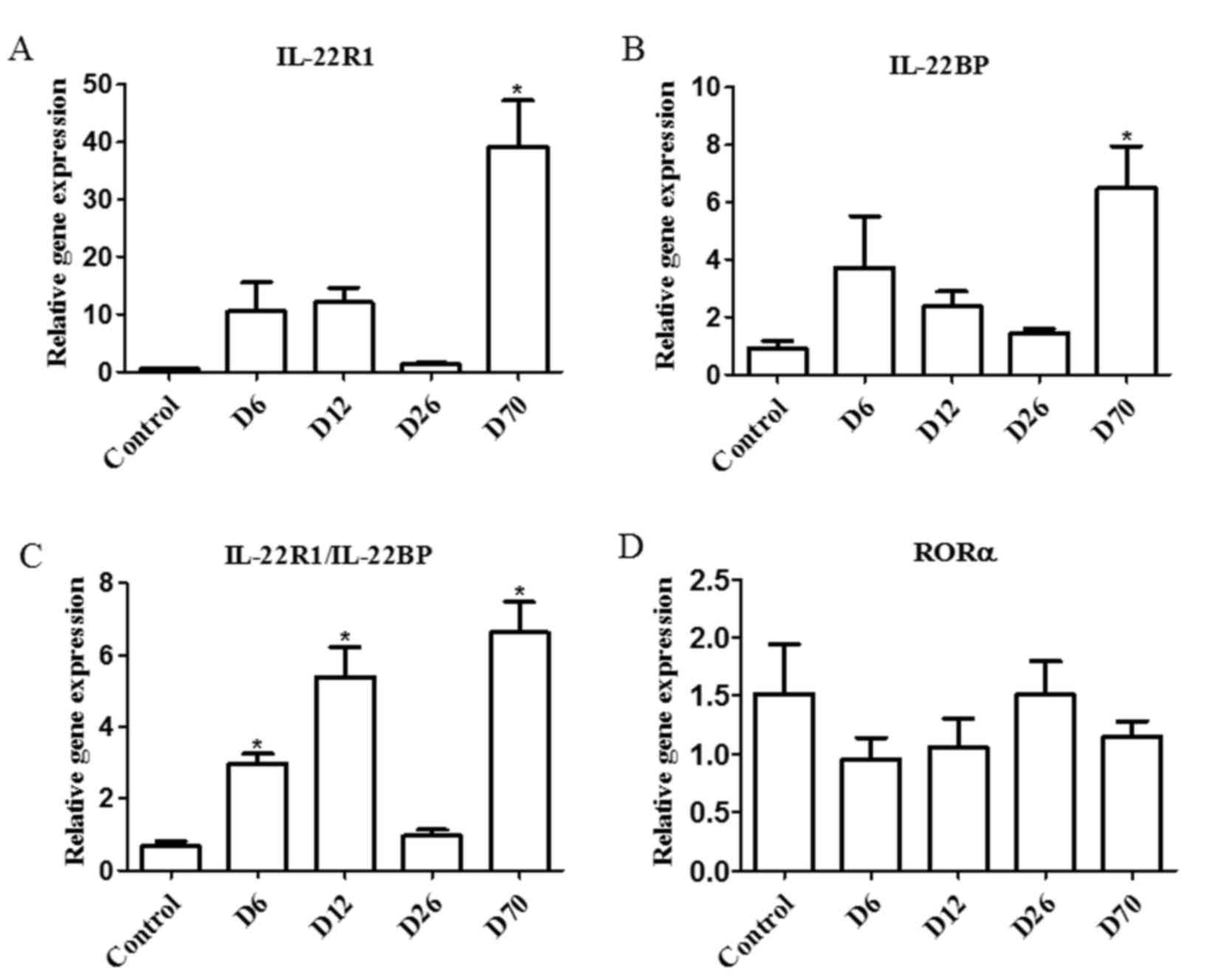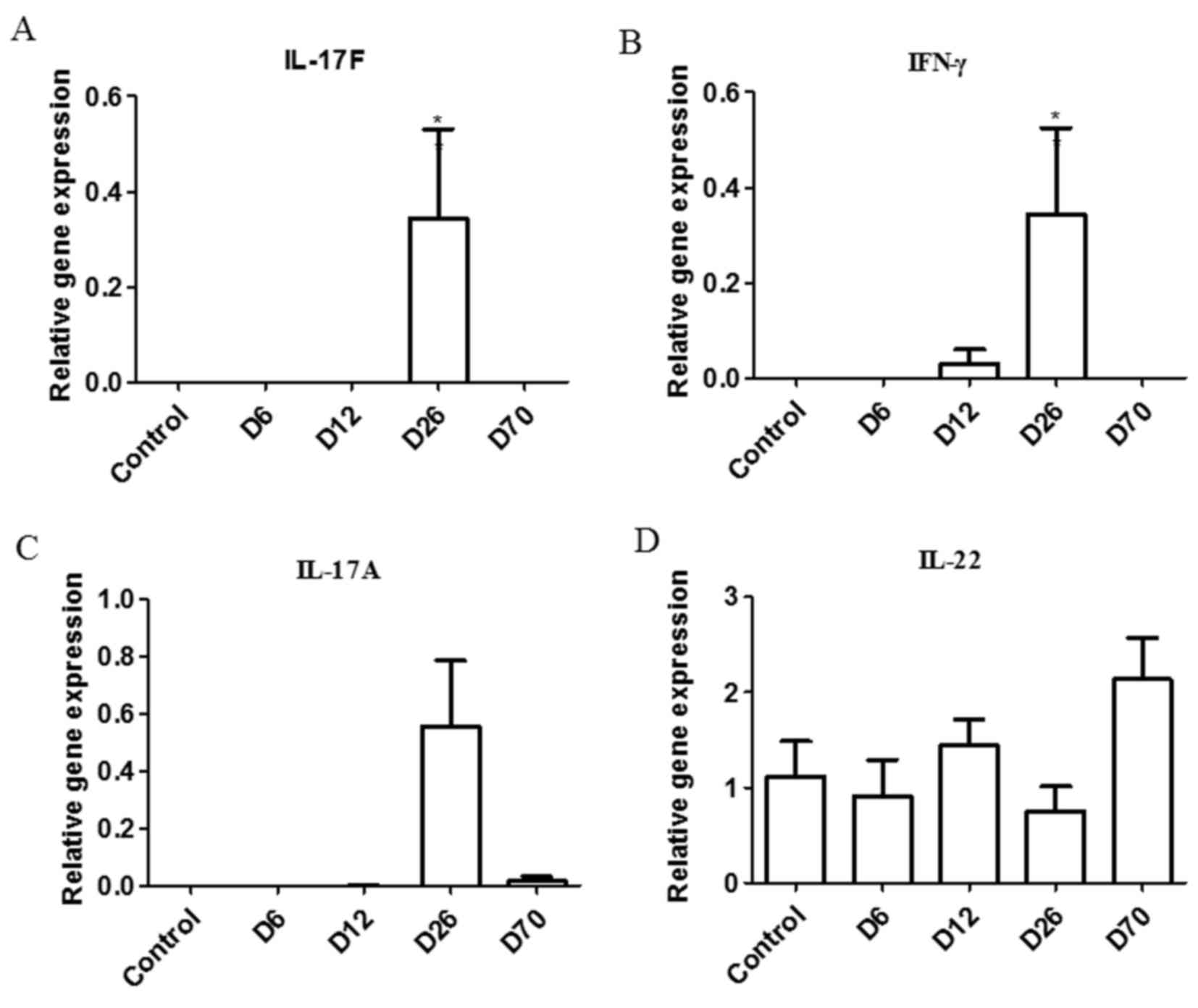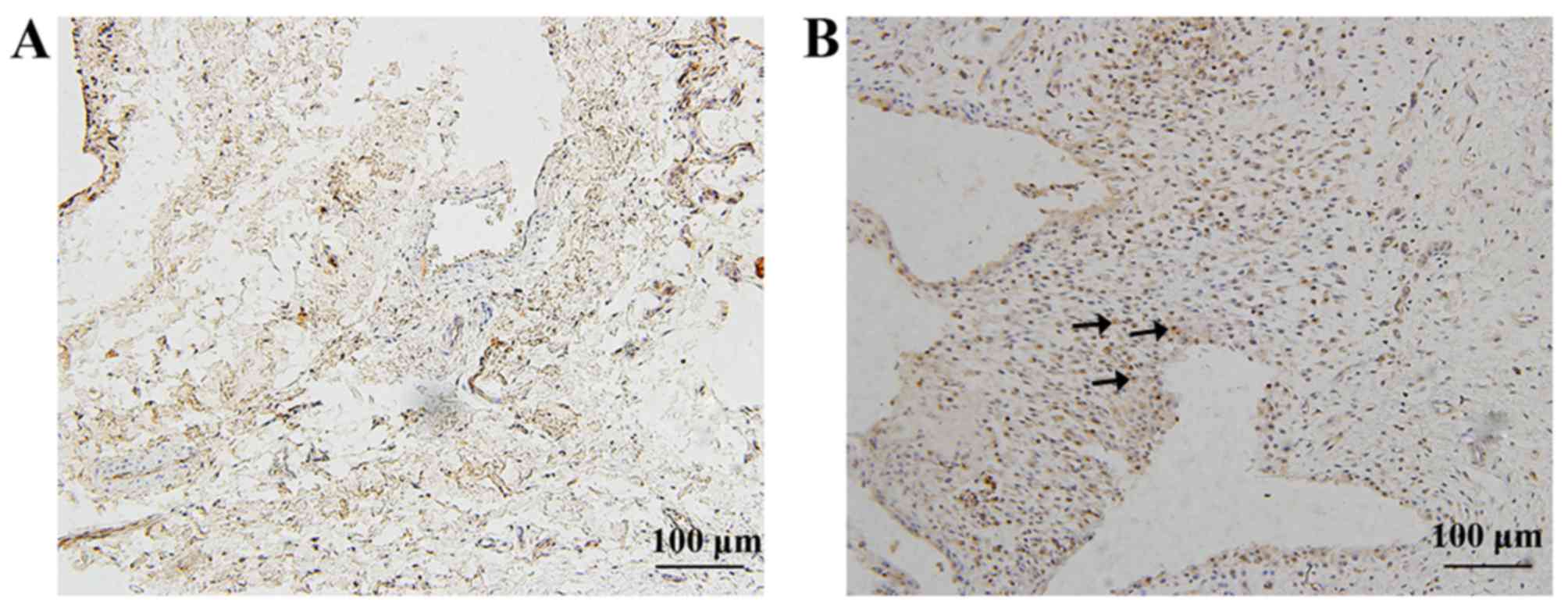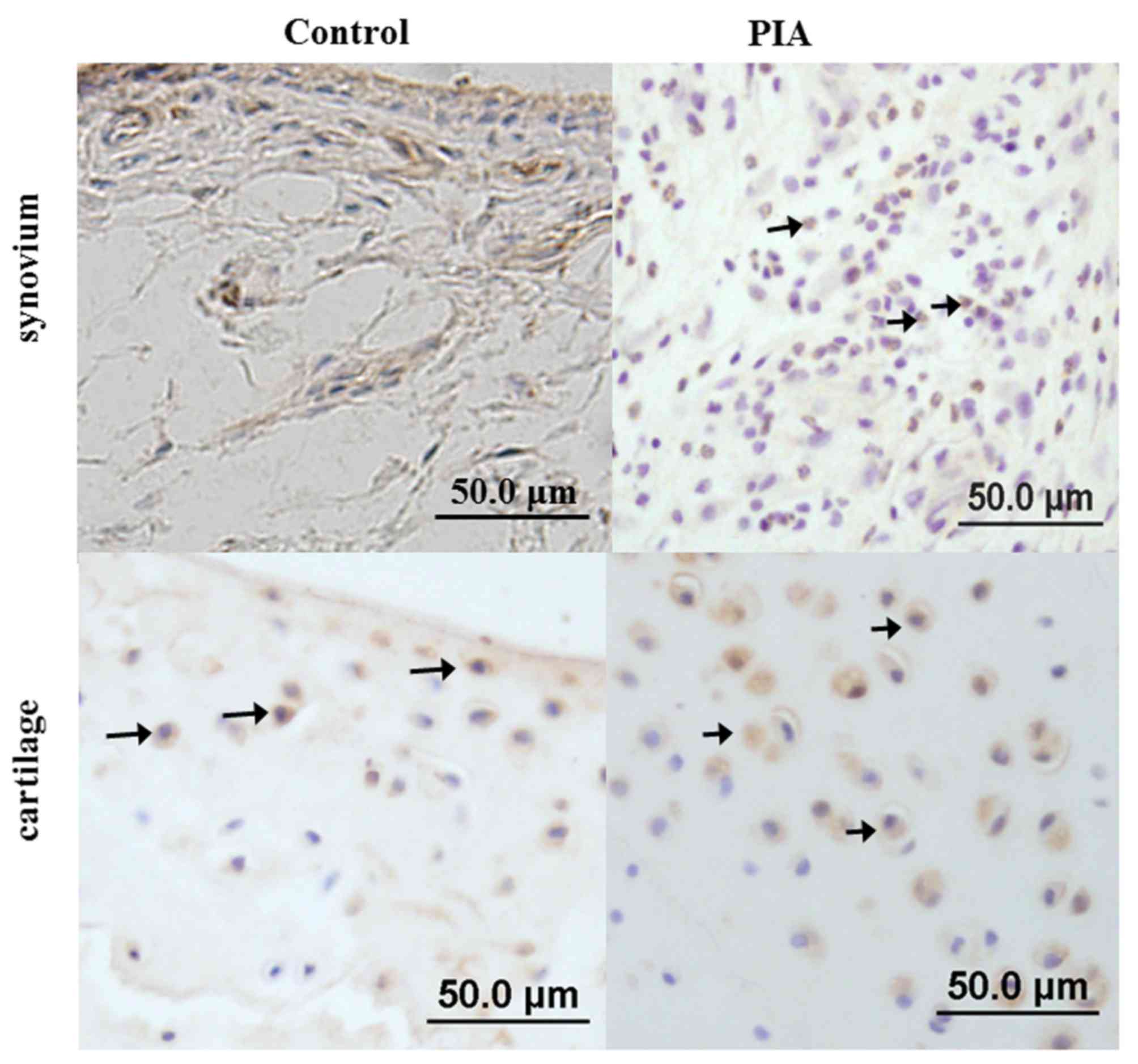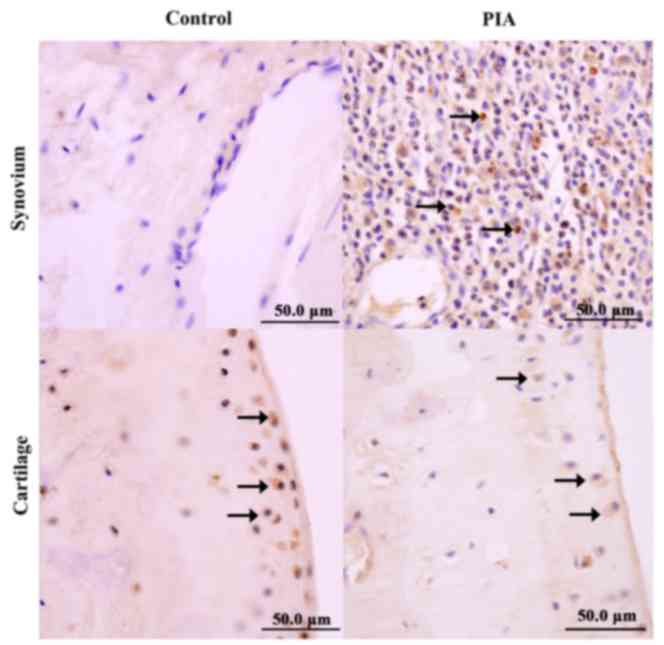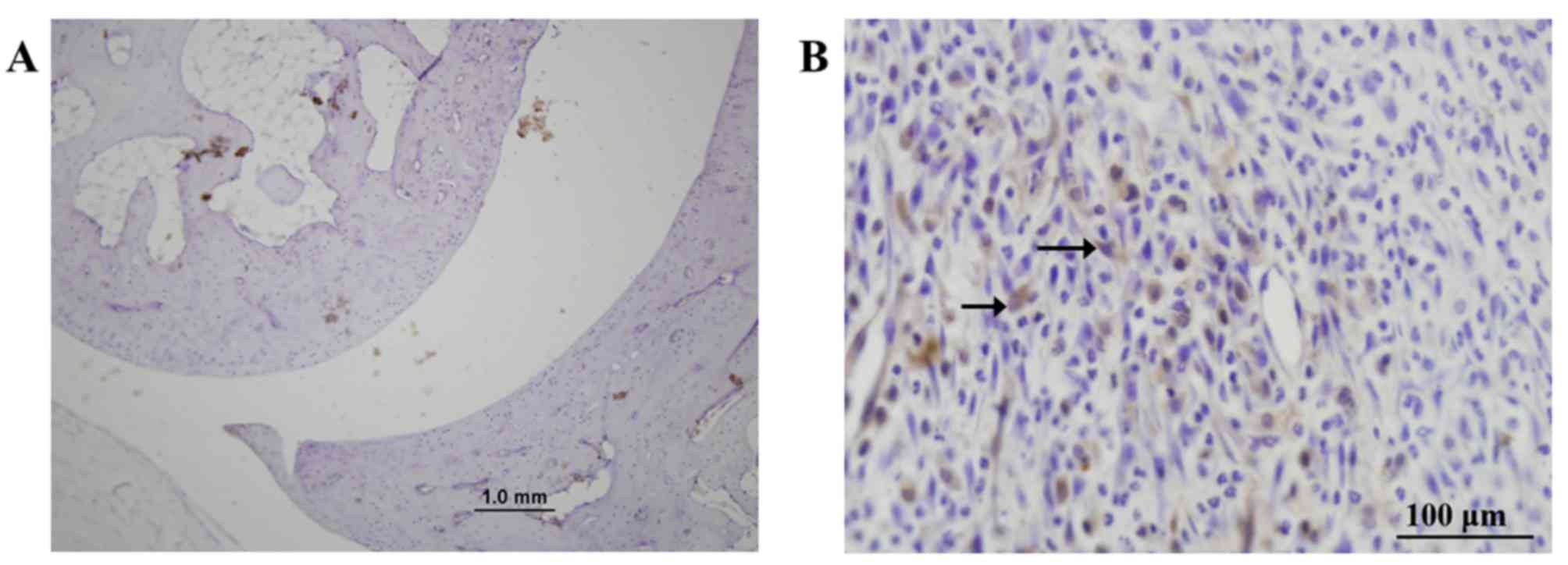IL‑22 expression is increased variedly in the initial phase, onset and chronic phase of a pristane‑induced arthritis rat model
- Authors:
- Published online on: June 9, 2017 https://doi.org/10.3892/mmr.2017.6739
- Pages: 1109-1116
-
Copyright: © Hou et al. This is an open access article distributed under the terms of Creative Commons Attribution License.
Abstract
Introduction
Rheumatoid arthritis (RA) is a chronic, inflammatory disease, with activated T cells serving important roles in the pathological progress (1,2). Pristane-induced arthritis (PIA) in rats is one of the animal models commonly used for the study of RA, and it exhibits many clinical features similar to human RA (3,4). Pristane is a small alkane molecule, that induces arthritogenic T cells and cannot form a stable complex with the major histocompatibility complex class II molecule. Therefore, the PIA rat model is suitable to study the pathological role of T cells or cytokines in arthritis progression (5,6).
T helper (Th) 17 cells were discovered in 2005, and were demonstrated to secrete interleukin (IL)-17A, IL-17F, IL-21 and IL-22, to express the key transcription factors RAR-related orphan receptor (ROR) γt and RORα, and to be important in local inflammation (7,8). Another subtype of T helper cells was discovered in 2009, Th22 cells, and were demonstrated to secrete IL-22, to exhibit the phenotype CCR4+CCR6+CCR10+ and to express the key transcription factor aryl hydrocarbon receptor (9). The receptor complex that binds IL-22 is IL-10 receptor (R) 2/IL-22R1. Since IL-10R2 is expressed ubiquitously, expression of IL-22R1 indicates the location of functional IL-22 signaling (10). In vivo, IL-22 binding protein (BP), a soluble form of the IL-22R1 subunit which binds IL-22 without activating downstream signaling, is a natural antagonist of IL-22 signaling (11). IL-17A and IL-22 are associated with RA or RA animal models. IL-17A mRNA expression levels are increased in RA patients and in the synovial tissues of collagen-induced arthritis (CIA) mice (12). IL-17A is also increased in the synovial fluid of patients with RA (13). Ikeuchi et al (14) reported that IL-22 mRNA expression levels are increased in the synovial tissues of patients with RA and that IL-22 is a pro-inflammatory cytokine, while Sarkar et al (15) reported that IL-22 reduces the severity of CIA and is protective against the disease in mice, suggesting that these two studies reported contradictory results. Further studies that will lead to a more comprehensive understanding of the expression pattern of IL-22 in an animal model of RA are thus needed.
In the present report, different time points were examined in a PIA rat model, in order to simulate the initial phase, onset, acute and chronic arthritis phases at 6, 12, 26 and 70 days following pristane injection, respectively. The expression of various Th17 and Th22 cell-related cytokines, cytokine receptors and transcription factors were measured in the different disease phases in the PIA rats. IL-17F and IFN-γ were significantly increased in the synovium of acute PIA rats, while IL-22 expression was increased predominantly in the chronic phase of PIA rats.
Materials and methods
Animals and the PIA model
Dark Agouti rats (originating from Zentralinstitut Fur Versuchstierzucht, Hannover, Germany) were bred in the animal house under specific pathogen-free conditions and with 12 h light/dark cycles. The rats were housed in polystyrene cages at 4 rats/cage with standard rodent chow and water ad libitum. A total of 42 rats (21 female and 21 male; age, 8 to 12 weeks; weight, 174.5±34.2 g), were randomly divided into two groups matched for sex and age. In the PIA group, rats were subcutaneously injected with 150 µl pure pristane (Acros Organics; Thermo Fisher Scientific, Inc., Waltham, MA, USA) at the base of the tail. Control rats were subcutaneously injected with 150 µl PBS and sacrificed at 26 days following the injection. The PIA group was then divided into four subgroups (8–10 rats per group), which were sacrificed at different days post-injection: Day (D) 6 was considered as the initial phase, D12 as the onset, D26 as acute arthritis and D70 as chronic arthritis (3). Rats were anesthetized by intraperitoneal administration of 2% pentobarbital sodium (0.15 ml/100 g body weight). Spleens and synovium from the right posterior ankles were harvested from the rats immediately following sacrifice, and stored at −80°C. The left posterior paws of the rats were removed and fixed with 4% paraformaldehyde at 20°C for 1 week, then decalcified in 12.5% EDTA solution at 20°C for 4 weeks, during which the solution was changed every two days. The decalcified samples were subsequently embedded in paraffin and cut into 6 µm tissue sections. The experiments were approved by the Institutional Animal Ethics Committee of the Xi'an Jiaotong University (Xi'an, China).
RNA isolation and reverse transcription (RT)
Total RNA was isolated from spleens and synovium using the TRIzol method (Invitrogen; Thermo Fisher Scientific, Inc.). Quantification of RNA samples was performed using a GeneQuest CE 2301 instrument (Cecil Instruments, Inc., Cambridge, UK), and samples with optical density (OD) 260/OD280 ratios of 1.8–2.0 were selected for further analysis. The quality of the extracted RNA was also examined using an automated gel imaging analysis system (Syngene, Frederick, MA, USA). cDNA was prepared by RT using the RevertAid First Strand cDNA synthesis kit, according to manufacturer's protocol (Fermentas; Thermo Fisher Scientific, Inc.).
Quantitative polymerase chain reaction (qPCR)
The cDNA product was diluted 8 times with pure water. PCR reactions were prepared with 4 µl diluted cDNA, 5 µl 2X SYBR® Premix Ex Taq™ II (Takara Biotechnology Co., Ltd., Dalian, China), 0.5 µl sense primers and 0.5 µl antisense primers into 200 µl PCR tubes, and then run on a iQ5 Real-Time PCR detection instrument (Bio-Rad Laboratories, Inc., Hercules, CA, USA). The reaction conditions were as follows: 95°C for 3 min, then 40 cycles of 95°C for 10 sec, annealing temperature for 20 sec (as illustrated in Table I for each primer) and 72°C for 20 sec. Primer sequences and annealing temperatures are listed in Table I, and β-actin was used as the internal control. Relative gene expression was calculated by the ΔΔCq method (16).
Immunohistochemistry
Immunohistochemistry was used to detect the location of IL-17A, IL-21, IL-22 and IL-22R1 expression in ankle tissues from D26 PIA and control rats. Samples were deparaffinized, retrieved for antigens by incubating compound enzymes at 37°C for 20 mins, washed with PBS buffer 3 times, and then they were incubated with 5% BSA (cat. no. ZLI-9027; Beijing Zhongshan Golden Bridge Biotechnology Co., Ltd, Beijing, China) in PBS buffer at 37°C for 20 mins. Samples were then incubated overnight at 4°C with primary antibodies, and normal rabbit serum (cat. no. ZLI-9025; Zhongshan Golden Bridge Biotechnology Co., Ltd) or goat serum (cat. no. ZLI-9056; Zhongshan Golden Bridge Biotechnology Co., Ltd) was used instead of primary antibody as a negative control. Primary antibodies were: Rabbit anti-IL-17A (cat. no. sc-7927; 1:100 dilution), goat anti-IL-21 (cat. no. sc-17649; 1:200 dilution) and goat anti-IL-22 (cat. no. sc-14436; 1:200 dilution) from Santa Cruz Biotechnology, Inc. (Dallas, TX USA) and goat anti-IL-22R1 (cat. no. AF2770; 1:200 dilution) from R&D Systems, Inc. (Minneapolis, MN, USA). Biotin conjugated secondary antibodies [goat anti-rabbit immunoglobulin (Ig)G (cat. no. ZB-2010) or rabbit anti-goat IgG (cat. no. ZB-2050), purchased from Zhongshan Golden Bridge Biotechnology Co., Ltd] with 1:1,000 dilutions, were incubated at 37°C for 20 min. Finally, the reaction was developed by adding the substrate reagent 3,30-diaminobenzidine tetrahydrochloride (DAB; Zhongshan Golden Bridge Biotechnology Co., Ltd) and the sections were counterstained with hematoxylin. A total of 18 slides per group (n=6 rats) were evaluated under a light microscope.
Statistical analysis
Results were analyzed by one-way analysis of variance followed by a Dunnett test using SPSS 15.0 software (SPSS, Inc., Chicago, IL, USA). P<0.05 was considered to indicate a statistically significant difference.
Results
Expression of cytokines in the spleen of PIA rats
The mRNA expression levels of IL-17A, IFN-γ and IL-22 were examined in the spleens of D6, D12, D26 and D70 PIA rats by RT-qPCR. The results demonstrated that, in the spleen, IL-17A exhibited an increasing trend in the D26 group but this was not statistically significant (Fig. 1A). IFN-γ mRNA expression levels increased significantly in the D70 group compared with the control group (Fig. 1B). IL-22 exhibited a trend towards increased expression in the D6 and D12 groups, and increased significantly in the D70 group compared with control (Fig. 1C).
Expression of cytokine receptors and transcription factors in the spleen of PIA rats
The mRNA expression levels of two types of IL-22 receptor, IL-22R1 and IL-22BP, and of the transcription factor RORα (which is predominantly expressed by Th17 cells), were examined in the spleens of D6, D12, D26 and D70 PIA rats by RT-qPCR. IL-22R1 expression levels were significantly increased in the D70 group compared with the control group (Fig. 2A). IL-22BP expression levels were increased in the D70 group as well (Fig. 2B). Since IL-22R1 is a functional receptor for IL-22, but IL-22BP is an antagonist of IL-22, the ratio of IL-22R1/IL-22BP expression was also calculated as a measure of IL-22 activity. The results demonstrated that the IL-22R1/IL-22BP ratio was significantly increased in the D6, D12 and D70 groups compared with control, a pattern similar with the expression pattern of IL-22 (Fig. 2C). Finally, the mRNA expression levels of the RORα transcription factor were not altered during the progression of the disease (Fig. 2D).
Expression of cytokines in the synovium of PIA rats
Ankle joints are the most affected joints in the PIA rat model. The pathological changes in the synovial tissue reflect the local disease condition (3). In the ankle synovium, the mRNA expression levels of IL-17F and IFN-γ were significantly increased in the D26 group compared with the control group (Fig. 3A and B). IL-17A expression appeared increased in the D26 group (Fig. 3C) and IL-22 expression appeared increased in the D70 group (Fig. 3D) compared with control, but none of these differences were significant.
Location of cytokines and cytokine receptor in the ankles of PIA rats
Immunohistochemistry analysis was used to detect the location of IL-17A, IL-21, IL-22 and IL-22R1 expression in the ankle joints of D26 PIA and control rats. The results demonstrated that IL-17A was mainly expressed in infiltrated inflammatory cells in PIA rats, while in the control group, few synovial cells were observed, the synovium was not proliferated and no IL-17A positive cells were detected (Fig. 4). In the PIA group, IL-21 was expressed in the infiltrated inflammatory cells, as well as in the proliferating layer of the articular cartilage (Fig. 5). A small number of proliferating chondrocytes in the normal control group were also positive for IL-21 expression (Fig. 5). Concerning IL-22 expression, in the PIA group, IL-22 was predominantly expressed in the infiltrated inflammatory cells located at invasion sites, and in a small number of cells in the proliferating layer of articular cartilage (Fig. 6). In the control group, however, IL-22 was expressed in the proliferating layer of the articular cartilage (Fig. 6). Finally, IL-22R1 was expressed in proliferated synovial cells in the PIA group (Fig. 7).
Discussion
The PIA rat model shares similar clinical features with RA, and its dominant features of different phases are two disease peaks, one at the acute phase and one at the chronic phase (17). As previously demonstrated, the onset arthritis phase in the PIA model is 12 days post-immunization, and the acute phase lasts from D12 to D32, then progresses to the chronic phase with a fluctuating incidence and level of disease (3).
Control rats were subcutaneously injected with PBS as it is pathogen free. A previous study revealed that, following an injection with PBS, there were no significant changes in the levels of cytokines in rats from day 0 to day 50 (4). Thus, in the present study, control group rats were sacrificed at 26 days following the injection, particularly as the PIA group rats exhibit the most serious clinical and pathological symptoms of the disease (4).
In the present study, the expression pattern of IL-22 was screened for the first time in the PIA rat model and IL-22 mRNA expression level was demonstrated to be varied in the different phases of PIA.
In the initial phase of arthritis, D6 group in the PIA rat model, which is prior to the onset phase, the deleterious factors have started to produce and migrate to the immune organs. Expression of IL-22 and IL-22R1 exhibited a trend to increased expression and the ratio of IL-22R1/IL-22BP in the spleen was increased compared with control. There was no significant change in the expression of the detected cytokines in the synovium. Geboes et al (18) used IL-22−/− mice to induce a CIA model, and demonstrated that CIA incidence was decreased and the severity of the disease was palliative compared with wild-type mice. Similar results were reported by Pinto et al (19) using an antigen-induced arthritis mouse model. These findings suggest that IL-22 may serve an important role in the initial phase of arthritis, earlier than other cytokines, in a systemic manner.
The next phase of arthritis progression is the onset phase, in which the immune reaction and pro-inflammatory factors transfer from the immune organs to target joints, thus inducing arthritis (3,17). In the present results, IL-22 expression had an increasing tendency and the ratio of IL-22R1/IL-22BP increased significantly in the spleens of PIA rats compared with control. In the synovium, IFN-γ, a pro-inflammatory factor, was positively detected. IL-22 has been hypothesized to play a protective role against arthritis in this phase. Sarkar et al (15) observed that administration of recombinant IL-22 during the effector phase in a CIA mouse model, delays the progression and severity of arthritis, and reduces the scores for inflammation, synovitis, and cartilage and bone damage in paws, and these effects are mediated through IL-10 production.
During the acute phase of arthritis, most pro-inflammatory factors are secreted and aggregated into joints (4). In the present study, IL-17F and IFN-γ were significantly increased in the synovium of PIA rats compared with control, while no significant changes were observed in IL-22 expression. IL-17A is the predominant cytokine secreted by Th17 cells, and it is related with many autoimmune diseases, including rheumatoid arthritis. IL-17A may be one of the key pro-inflammatory factors and may mediate the pathological progress of synovitis during the acute phase of arthritis. IL-17A expression levels are increased both in the synovium and synovial fluid of patients with RA and in the inflammatory synovial tissues of CIA mice (13). Intra-articular injection of IL-17A in wild-type mice can induce symptoms similar to RA, while injection with a neutralizing anti-murine IL-17A antibody after the onset of CIA reduces joint inflammation, cartilage destruction, and bone erosion, and decreases the serum level of IL-6 (20–22). In IL-17A−/− mice, the progression of CIA is suppressed and the production of antigen specific T cells and collagen specific IgG2a is also influenced (23). IL-17A promotes the production of granulocyte macrophage colony-stimulating factor and prostaglandin E2 in synovial cells, and promotes macrophages to produce IL-1 and tumor necrosis factor-α (20,22,24). IL-17A promotes the differentiation of osteoclasts by inducing expression of receptor activator of nuclear factor kB ligand in osteoblasts (25). IL-17A induces synovial cells and chondrocytes to produce matrix metalloproteinases, promotes the degradation of extracellular matrix and inhibits the synthesis of proteoglycans and collagens, which are the main components of matrix repair (26–28). Ikeuchi et al (14) reported that IL-22 induces synovial fibroblast proliferation and monocyte chemotactic protein-1 production in vitro. In the present results, the role of IL-22 may be covered by other pro-inflammatory factors.
Progression to the chronic phase is one of the key features of RA, with disease fluctuation and lasting progression (29). In the present study, IL-22 expression in the spleen of PIA rats was demonstrated to be increased predominantly in the chronic phase, an expression pattern that was similar to the IL-22R1/IL-22BP expression ratio in PIA rats. Of note, IL-22 expression in the synovium was stable during the disease progression, except in the chronic phase, which exhibited a trend towards increased expression. This indicated that IL-22 may be important systemically and locally. Previously, it has been reported that the predominant pathological features of PIA in the chronic phase are the destruction and repair of joints (3). IL-22 may serve important roles in the joint repair process. Marijnissen et al (30) observed that IL-22 neutralization does not influence the number of osteoclasts, but induces a significant reduction in bone erosion. Geboes et al (18) reported that IL-22R1 is expressed in osteoclast precursors, a CD11b+ fraction of splenocytes, and that IL-22 stimulates osteoclast differentiation and activity. In IL-22−/− mice, synovial tissue hyperplasia and pannus formation was reduced compared with wild-type mice (18).
In conclusion, the present results demonstrated that, in PIA rats, IL-17F and IFN-γ expression increased in the synovium during the acute phase of arthritis. In addition, IL-22 increased predominantly in the spleen during the chronic phase of arthritis, with an increasing trend observed in the initial and onset phases in the spleen and in the chronic phase in the synovium. Further studies will be necessary in order to establish the role of IL-22 in the various cytokine milieus and in the different phases of arthritis progression.
Acknowledgements
The authors wish to thank Mr. Fujun Zhang for the excellent work at histological and pathological research. The present study was supported by grants from the National Natural Science Foundation of China (grant no. 81201373) and Postdoctoral Foundation of Shaanxi Province (grant no. 2016BSHEDZZ93).
References
|
Huber LC, Distler O, Tarner I, Gay RE, Gay S and Pap T: Synovial fibroblasts: Key players in rheumatoid arthritis. Rheumatology (Oxford). 45:669–675. 2006. View Article : Google Scholar : PubMed/NCBI | |
|
O'Mahony R, Richards A, Deighton C and Scott D: Withdrawal of disease-modifying antirheumatic drugs in patients with rheumatoid arthritis: A systematic review and meta-analysis. Ann Rheum Dis. 69:1823–1826. 2010. View Article : Google Scholar : PubMed/NCBI | |
|
Hou W, Meng L, Tian L, Zhu W, Jiang C and Lu S: A systematic comparison between collagen-induced arthritis and pristane-induced arthritis in Dark Agouti rats. Clin Exp Rheumatol. 28:532–538. 2010.PubMed/NCBI | |
|
Vingsbo C, Sahlstrand P, Brun JG, Jonsson R, Saxne T and Holmdahl R: Pristane-induced arthritis in rats: A new model for rheumatoid arthritis with a chronic disease course influenced by both major histocompatibility complex and non-major histocompatibility. complex genes. 149:1675–1683. 1996. | |
|
Lu S, Nordquist N, Holmberg J, Olofsson P, Pettersson U and Holmdahl R: Both common and unique susceptibility genes in different rat strains with pristane-induced arthritis. Eur J Hum Genet. 10:475–483. 2002. View Article : Google Scholar : PubMed/NCBI | |
|
Holmberg J, Tuncel J, Yamada H, Lu S, Olofsson P and Holmdahl R: Pristane, a non-antigenic adjuvant, induces MHC class II-restricted, arthritogenic T cells in the rat. J Immunol. 176:1172–1179. 2006. View Article : Google Scholar : PubMed/NCBI | |
|
Harrington LE, Hatton RD, Mangan PR, Turner H, Murphy TL, Murphy KM and Weaver CT: Interleukin 17-producing CD4+ effector T cells develop via a lineage distinct from the T helper type 1 and 2 lineages. Nat Immunol. 6:1123–1132. 2005. View Article : Google Scholar : PubMed/NCBI | |
|
Solt LA, Kumar N, Nuhant P, Wang Y, Lauer JL, Liu J, Istrate MA, Kamenecka TM, Roush WR, Vidović D, et al: Suppression of TH17 differentiation and autoimmunity by a synthetic ROR ligand. Nature. 472:491–494. 2011. View Article : Google Scholar : PubMed/NCBI | |
|
Duhen T, Geiger R, Jarrossay D, Lanzavecchia A and Sallusto F: Production of interleukin 22 but not interleukin 17 by a subset of human skin-homing memory T cells. Nat Immunol. 10:857–863. 2009. View Article : Google Scholar : PubMed/NCBI | |
|
Wolk K, Witte E, Witte K, Warszawska K and Sabat R: Biology of interleukin-22. Semin Immunopathol. 32:17–31. 2010. View Article : Google Scholar : PubMed/NCBI | |
|
Dumoutier L, Lejeune D, Colau D and Renauld JC: Cloning and characterization of IL-22 binding protein, a natural antagonist of IL-10-related T cell-derived inducible factor/IL-22. J Immunol. 166:7090–7095. 2001. View Article : Google Scholar : PubMed/NCBI | |
|
Sarkar S, Justa S, Brucks M, Endres J, Fox DA, Zhou X, Alnaimat F, Whitaker B, Wheeler JC, Jones BH and Bommireddy SR: Interleukin (IL)-17A, F and AF in inflammation: A study in collagen-induced arthritis and rheumatoid arthritis. Clin Exp Immunol. 177:652–661. 2014. View Article : Google Scholar : PubMed/NCBI | |
|
Ziolkowska M, Koc A, Luszczykiewicz G, Ksiezopolska-Pietrzak K, Klimczak E, Chwalinska-Sadowska H and Maslinski W: High levels of IL-17 in rheumatoid arthritis patients: IL-15 triggers in vitro IL-17 production via cyclosporin A-sensitive mechanism. J Immunol. 164:2832–2838. 2000. View Article : Google Scholar : PubMed/NCBI | |
|
Ikeuchi H, Kuroiwa T, Hiramatsu N, Kaneko Y, Hiromura K, Ueki K and Nojima Y: Expression of interleukin-22 in rheumatoid arthritis: Potential role as a proinflammatory cytokine. Arthritis Rheum. 52:1037–1046. 2005. View Article : Google Scholar : PubMed/NCBI | |
|
Sarkar S, Zhou X, Justa S and Bommireddy SR: Interleukin-22 reduces the severity of collagen-induced arthritis in association with increased levels of interleukin-10. Arthritis Rheum. 65:960–971. 2013. View Article : Google Scholar : PubMed/NCBI | |
|
Livak KJ and Schmittgen TD: Analysis of relative gene expression data using real-time quantitative PCR and the 2(−Delta Delta C(T)) Method. Methods. 25:402–408. 2001. View Article : Google Scholar : PubMed/NCBI | |
|
Olofsson P and Holmdahl R: Pristane-induced arthritis in the rat. Methods Mol Med. 136:255–268. 2007. View Article : Google Scholar : PubMed/NCBI | |
|
Geboes L, Dumoutier L, Kelchtermans H, Schurgers E, Mitera T, Renauld JC and Matthys P: Proinflammatory role of the Th17 cytokine interleukin-22 in collagen-induced arthritis in C57BL/6 mice. Arthritis Rheum. 60:390–395. 2009. View Article : Google Scholar : PubMed/NCBI | |
|
Pinto LG, Talbot J, Peres RS, Franca RF, Ferreira SH, Ryffel B, Aves-Filho JC, Figueiredo F, Cunha TM and Cunha FQ: Joint production of IL-22 participates in the initial phase of antigen-induced arthritis through IL-1β production. Arthritis Res Ther. 17:2352015. View Article : Google Scholar : PubMed/NCBI | |
|
Fossiez F, Djossou O, Chomarat P, Flores-Romo L, Ait-Yahia S, Maat C, Pin JJ, Garrone P, Garcia E, Saeland S, et al: T cell interleukin-17 induces stromal cells to produce proinflammatory and hematopoietic cytokines. J Exp Med. 183:2593–2603. 1996. View Article : Google Scholar : PubMed/NCBI | |
|
Jovanovic DV, Di Battista JA, Martel-Pelletier J, Jolicoeur FC, He Y, Zhang M, Mineau F and Pelletier JP: IL-17 stimulates the production and expression of proinflammatory cytokines, IL-beta and TNF-alpha, by human macrophages. J Immunol. 160:3513–3521. 1998.PubMed/NCBI | |
|
Katz Y, Nadiv O and Beer Y: Interleukin-17 enhances tumor necrosis factor alpha-induced synthesis of interleukins 1,6 and 8 in skin and synovial fibroblasts: A possible role as a ‘fine-tuning cytokine’ in inflammation processes. Arthritis Rheum. 44:2176–2184. 2001. View Article : Google Scholar : PubMed/NCBI | |
|
Kotake S, Udagawa N, Takahashi N, Matsuzaki K, Itoh K, Ishiyama S, Saito S, Inoue K, Kamatani N, Gillespie MT, et al: IL-17 in synovial fluids from patients with rheumatoid arthritis is a potent stimulator of osteoclastogenesis. J Clin Invest. 103:1345–1352. 1999. View Article : Google Scholar : PubMed/NCBI | |
|
Jovanovic DV, Di Battista JA, Martel-Pelletier J, Jolicoeur FC, He Y, Zhang M, Mineau F and Pelletier JP: IL-17 stimulates the production and expression of proinflammatory cytokines, IL-beta and TNF-alpha, by human macrophages. J Immunol. 160:3513–3521. 1998.PubMed/NCBI | |
|
Kotake S, Udagawa N, Takahashi N, Matsuzaki K, Itoh K, Ishiyama S, Saito S, Inoue K, Kamatani N, Gillespie MT, et al: IL-17 in synovial fluids from patients with rheumatoid arthritis is a potent stimulator of osteoclastogenesis. J Clin Invest. 103:1345–1352. 1999. View Article : Google Scholar : PubMed/NCBI | |
|
Chabaud M, Garnero P, Dayer JM, Guerne PA, Fossiez F and Miossec P: Contribution of interleukin 17 to synovium matrix destruction in rheumatoid arthritis. Cytokine. 12:1092–1099. 2000. View Article : Google Scholar : PubMed/NCBI | |
|
Benderdour M, Tardif G, Pelletier JP, Di Battista JA, Reboul P, Ranger P and Martel-Pelletier J: Interleukin 17 (IL-17) induces collagenase-3 production in human osteoarthritic chondrocytes via AP-1 dependent activation: Differential activation of AP-1 members by IL-17 and IL-1beta. J Rheumatol. 29:1262–1272. 2002.PubMed/NCBI | |
|
Koshy PJ, Henderson N, Logan C, Life PF, Cawston TE and Rowan AD: Interleukin 17 induces cartilage collagen breakdown: Novel synergistic effects in combination with proinflammatory cytokines. Ann Rheum Dis. 61:704–713. 2002. View Article : Google Scholar : PubMed/NCBI | |
|
Grassi W, de Angelis R, Lamanna G and Cervini C: The clinical features of rheumatoid arthritis. Eur J Radiol. 27 Suppl 1:S18–S24. 1998. View Article : Google Scholar : PubMed/NCBI | |
|
Marijnissen RJ, Koenders MI, Smeets RL, Stappers MH, Nickerson-Nutter C, Joosten LA, Boots AM and van den Berg WB: Increased expression of interleukin-22 by synovial Th17 cells during late stages of murine experimental arthritis is controlled by interleukin-1 and enhances bone degradation. Arthritis Rheum. 63:2939–2948. 2011. View Article : Google Scholar : PubMed/NCBI |




